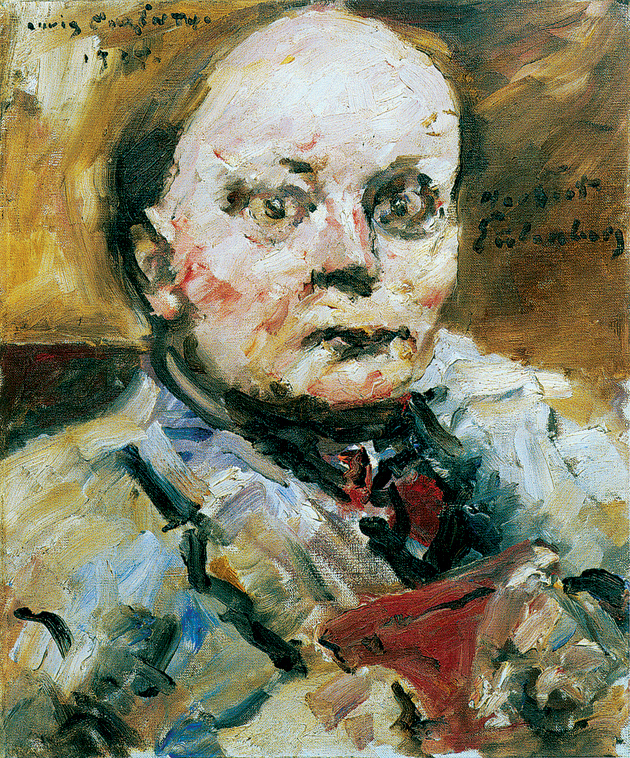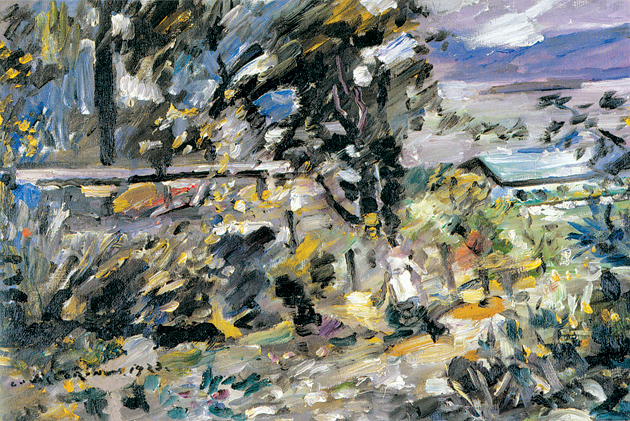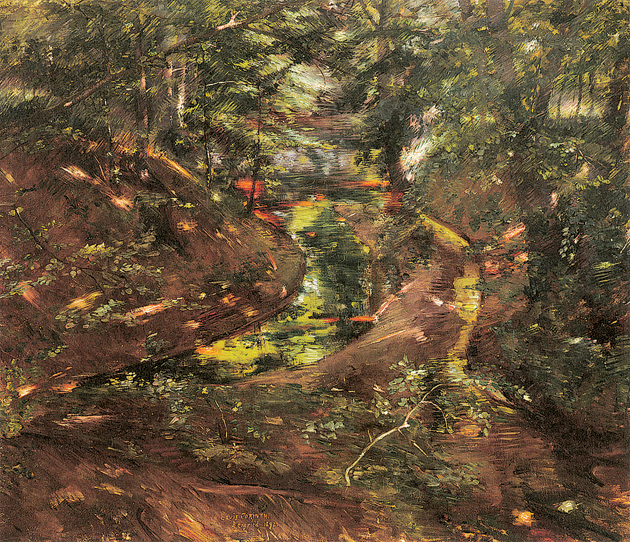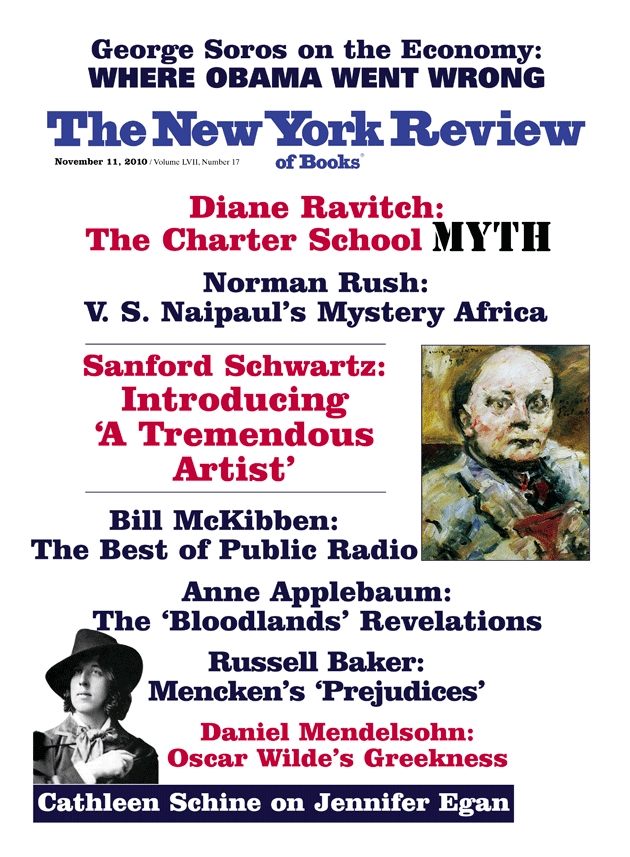Lovis Corinth, who died in 1925, at sixty-seven, has long been a hazily known figure for the wider museumgoing public in this country. But at least in New York, artists and art writers, in my experience, have kept aware of this German artist’s landscapes and portraits because he had an uncommon feeling for the sensuous properties of the different mediums he took up, and, even more, because there can be a rare jabbing urgency to his touch as a painter, draftsman, and printmaker. In his best pictures, we follow an artist who moved at such apparent breakneck speed to fix in place the feelings that brought him to his subject that his images seem almost literally to tingle and vibrate as we look at them.
But Corinth also holds our attention because there is a gripping biographical component to his work: as he aged, his art became increasingly audacious. A little like Marsden Hartley and Philip Guston at comparable stages in their lives, he evolved in his fifties and sixties into almost a new artist. He became, in fact, the charging, seemingly impulse-driven creator some of us have responded to.
Based in Munich in the 1890s and in Berlin from 1901 on, Corinth all along had the ambition of being a modern-day Rembrandt, Hals, and Rubens rolled into one. Working with a highly accomplished brushy style, he was a perceptive portraitist, and he also made occasional landscapes and city scenes. He was capable of strong and frankly carnal female nudes and, less appealingly, images of full-bodied women in various states of undress that probably seemed obvious even at the time. His greater effort, though, went into frequently large paintings based on stories from the Bible and a range of literary sources, and these works, which might be about the temptation of Saint Anthony or Christ’s deposition from the cross, were also highly eroticized—and rather bombastic.
They are not academic waxworks, though. They are stranger and goofier than that. With his 1909 Homeric Laughter, First Version, for example, where Venus, Mars, Jupiter, and other gods are impersonated by mugging, all-too-contemporary models, or his 1900 Salome, Second Version, where a whorishly luscious and bejeweled Salome examines the freshly chopped-off head of John the Baptist, we are not sure what the artist believes about these raucous burlesques. This keeps them from feeling dated. Yet they aren’t pictures we especially want to return to.
Then in December 1911, at the age of fifty-three, Corinth suffered a stroke that kept him from any work for a while. His left arm and leg never fully recovered, and his right hand—he was right-handed—might thereafter shake uncontrollably. Yet this hand moved quite serviceably when he painted or wrote, and for the remaining fourteen years of his life, at a time when most artists realize that their major discoveries are behind them, Corinth found himself taking up new themes, reimagining or discarding old themes, and working with a sense of belief that had been there only sporadically before. When he now turned to subject matter from literature or history, which was far less frequently, he gradually dropped the garish and farcical grandstanding of his earlier efforts and presented the story of Noah, say, or the exploits of Frederick the Great, or the moment when Pilate presents Christ to the crowd, in ways that are by turns funny, fairy tale–like, quietly intimate, or genuinely tormented.
In his last decade or so, as he became increasingly involved with portraits, landscapes, and still lifes, Corinth’s brushwork became ever more impetuous and driving. There are later paintings where his thickly oily brush-marks rain down with such seeming speed as to give the impression that the image is warping, before our eyes, into something else. There are some paintings and numerous graphic works where, without a title, a viewer might not even be sure of what is being represented.
Was this new velocity, with its residual raggedness and often grayed and muddied tones, taking place because Corinth was disabled and couldn’t work any other way? His wife, the artist Charlotte Berend-Corinth, his son Thomas, and his daughter Wilhelmine, in the books they published about him, didn’t say this was the case at all; and taking in his often fiercely spirited later pictures, which feel like organic extensions of his earlier ones, this probably unanswerable question hardly seems to matter.
What undoubtedly spurred him in his last years was that he had dramatically come up against his own mortality and, as his biographer Horst Uhr has suggested, the incident made him respond to life with a new freedom and gravity. One certainly feels this in looking at his powerful later portraits, which have an expressionistic force yet are different from the portraits the Expressionists did. Corinth, who was a generation older than Max Beckmann, Oskar Kokoschka, and the rest, never bathes his sitters, as the younger painters might, in an atmosphere of irony, or sees them as depleted or as personifications of a social class or an idea. His aim is somehow deeper and more all-encompassing, and it can best be felt in the glistening and deep-set eyes of so many of his portrait subjects. The way Corinth’s sitters look out at the world makes us feel that they are not victims or types so much as people handling stark and fundamental realizations about themselves.
Advertisement
For his non-German-speaking admirers, Lovis Corinth has been a figure more to speculate about than to know. This is largely because there have been so few publications or comprehensive shows devoted to him, and very few of his significant paintings are outside German collections. But the situation has been changing. In 1996 and 1997, a full retrospective, which went from Munich to Berlin and concluded at the Tate, had a stop at the St. Louis Art Museum (and was accompanied by a hefty and abundantly illustrated catalog entitled Lovis Corinth). It was the only major exhibition the artist has had in the States since 1964, when, at the old Gallery of Modern Art, on Columbus Circle, he had his one big New York showing.
Two years ago Corinth was finally seen in a retrospective in Paris, at the Musée d’Orsay. Now the Museum of Fine Arts, Houston, working with the Wallraf-Richartz-Museum, in Cologne, has given us “German Impressionist Landscape Painting,” in which works by Max Liebermann and Max Slevogt are shown along with works by Corinth—and we have our first chance to see how the artist stacks up next to his immediate contemporaries. In addition, people who want to look into the subject and don’t read German finally have, in Lovis Corinth: A Feast of Painting, a trim and easily handled way to begin. Published to coincide with a show at the Belvedere, in Vienna, last year, the book gives a good overview of a sprawlingly large body of paintings. Viewers unfamiliar with Corinth may be struck in particular by pictures in it such as a hallucinatory 1924 portrait of the writer Herbert Eulenberg, an image of a man with dampish-looking, pasty white skin, startling eyes, and a sort of unanchored mouth, all set atop a turbulent mess of brushstrokes constituting the sitter’s clothes and hands.
Some of the articles in the Vienna volume, though, including one by a doctor on the nature of Corinth’s stroke, are rather diffuse. This is also the case with the contributions in general to the St. Louis and Houston catalogs, a factor that may arise from many of the commentaries being translations from German. In German Impressionist Landscape Painting, for example, the relationships between the three artists and their roles and reputations in the wider art world of the time aren’t brought forth with enough clarity (and one has to search for such basics as their respective birth and death dates). I learned more about the relative achievements and limitations of these painters, and where they fit among their contemporaries, in a few pages in the late Kermit Champa’s forthright German Painting of the 19th Century (1970).
Then, too, there is something unclear about the Houston exhibition’s very premise. Walking through the show, one keeps wondering: Is this Impressionism? Corinth, Liebermann (1847–1935), and Slevogt (1868–1932) were, it is true, called Impressionists in their time. They thought of themselves as colleagues of a sort and, like Corinth, Liebermann and Slevogt were also portraitists and makers of literary or mythological pictures who with age became increasingly involved with landscape painting. Although their overall approaches were dissimilar, they painted in a loose, sketchy manner and were sensitive to the effects of light, qualities that roughly—to our eyes very roughly—aligned their pictures with the classic Impressionist landscapes that Monet, Sisley, and others made in the 1870s.
What perhaps provided a second reason for the Berlin painters to have been labeled “Impressionists” is that, at the turn of the century, they were the most Frenchified, or internationalized, in spirit of the city’s significant artists. Liebermann and Corinth had studied in Paris earlier in their lives, and all of them continued to welcome new art coming from Paris after the Impressionist heyday.
The show’s unintended point, however, is that Germans can take only so much Frenchness. Except for those by Corinth, the pictures are decidedly unenergizing—which is a little heartbreaking, because they have been presented with care in the elegantly high-ceilinged, naturally lit rooms of the museum’s Beck Building. It is a treat to see each of the artists in little bits of period film footage, and the catalog accompanying the show, unsatisfying as it is to read, has been handsomely produced. Yet unless one were making a case for emotionally muted (or emotionally nonexistent) paintings, it is hard to get anywhere with Max Slevogt. His blondish pictures of vineyards, the racetrack, and countryside villas, put together with modestly dapper brushwork, are the visual equivalent of someone mumbling. One forgets them as one looks at them.
Advertisement
Liebermann is another matter—although taken purely as an artist, he is not much more involving. The subject of a retrospective that began in Los Angeles in 2005 and came to the Jewish Museum in New York the following year, Liebermann, in his landscapes, at least seems to have more on his mind than a feeling for brushstrokes. An admirer of traditional Dutch values of civility and communal well-being (he spent every summer in Holland for decades), he made out of his pictures of Dutch enclosed courtyards, of the way people congregate on beaches, and, lastly, of his own gardens at Wannsee, outside Berlin, an art about balance and order. And because of what we know about Liebermann himself, it is not such a stretch to see in his images an underlying vision of social cohesion.
In many ways, his work and life together stood for the idea of finding accords—or, more precisely, for the possibility of Jews being assimilated in the Kaiser’s Germany. Liebermann was a portraitist of psychological acuity and tact, and in his years as a founder and the first president of the Berlin Secession, the city’s more progressive artists’ association—and as a conscientious and public-minded collector of Manet and other new French art—he was long a constructive presence in German cultural life. Then his efforts were simply blown away. With the 1933 elections, the newly empowered Nazis informed him that his career was over. He became a recluse in his Wannsee house, dying there two years later. He was, at least, spared the ordeal of his wife who, eight years after that, learning that she was about to be rounded up, committed suicide in their house.
So whether he shows people commingling on beaches or rows of different flowers sharing one garden, one can’t help seeing Liebermann’s pictures as emblems of a tragically dashed hope. Yet the pictures on their own, marked by a sense of painterly refinement held abstemiously in check, give less. We look at brushwork and color in generally small works that surely, we feel, needn’t be so mousy and utilitarian. (Could he believe that to paint with more drama would violate the social precepts he held?) At the most, we respond to the underlying horizontal, vertical, or diagonal elements in Liebermann’s images. He would have been, it seems, an abstract painter in a later era.
If Liebermann’s art is about a kind of selflessness, and expresses, however cautiously, an idea about human and formal relationships, Corinth’s art gives us the complete opposite. His work lacks (or is free of) larger ideas and presents, rather, one person’s continuous, lifelong quest to pin down and embody his particular instinctive responses. Corinth has been called the Kaspar Hauser of modern German art (by Peter-Klaus Schuster in the St. Louis catalog), and the label, with its sense of a primitive being who is dropped into civilization from nowhere, is astute. Absorbing his work with its stew-like mixture of portraits, views of places, and images taken from mythology, history, and everyday life, we follow an autodidact: an artist who makes a picture of Christ’s crucifixion, say, because he needs to let his audience know what his thinking on this subject is at that moment.
Corinth was even in his person a bit of a Kaspar Hauser. He was a big, bearish man from the farming region of East Prussia whose higher education was limited to what he picked up in art academies and who struck observers in Munich and Berlin as a rube. His ability to consume alcohol was prodigious (it is probably what caused his stroke). Yet he was a canny and unpredictable rube.
He is known to have suffered for much of his life from depression and feelings of worthlessness, and in social gatherings he could appear to have no verbal skills. He was shrewdly aware of the needs of his career, however, and in time he became a Berlin celebrity whose doings were followed in the papers. He wrote manuals on his painting and his printmaking as well as a study of the work of his friend the artist Walter Leistikow. All the while he was keeping a diary, which was published after his death as his autobiography. His account of the ups and downs of the Berlin Secession has been called by Schuster “very vivid, thorough and fair.”
For some viewers, and perhaps for the organizers of Houston’s exhibition, the most exciting aspect of “German Impressionist Landscape Painting” is the chance it gives to see Corinth’s late landscapes. Done at Walchensee, a large lake in the Bavarian Alps where the painter and his family had a country retreat (thanks to Charlotte, who found the property and had a house built there in 1919), these lakeside pictures have taken a special place in German, even European, twentieth-century art. They are views from high up of water, trees, mountains, and distant little buildings, seen at every time of day and in all seasons. Corinth had never painted this particular kind of terrain before, and in his excitement he made, in the remaining six years of his life, some sixty paintings and innumerable graphic works of the place.
More, perhaps, than any other kind of work he did, the Walchensee pictures show how radically Corinth could abbreviate, scramble, and shred forms in his effort to grasp what was before him. The lakeside paintings and works on paper present him at his most sheerly exploratory, animated, and windswept. Walchensee, Silver Path (1923), for instance, a view of trees, flowers, distant rooftop, and lake and mountains beyond, might at first appear to be a nonrepresentational jumble of squiggles, dashes, and dots. Lush and combustible, it is a work one wants to see along with the dizzying Céret landscapes that the young Chaim Soutine was doing at roughly the same time, or with the brusque, chiseled-looking views David Bomberg would make in Ronda in the 1930s—or with Frank Auerbach’s more recent scenes, done with a similar staccato touch, of London construction sites.
The surprise of Houston’s show, on the other hand, is how good Corinth’s earlier landscapes are—those done before his stroke. In the Forest at Bernried (1892), a view of a creek with sunlight poking its way through the trees, and The New Lake in the Berlin Tiergarten (possibly 1908), which shows a boathouse with rental boats, flags flying overhead, and their reflections in the water, are the strongest of the many first-rate and ambitiously large paintings in the show from the first part of the artist’s career. Made up of many interconnecting, feathered-in little brushstrokes, and subtly sumptuous in their color and oil paint surfaces, they seemed, simply, more beautiful than most of the more celebrated Walchensee works. (This might be called an inconvenient taste.)
Do these early successes upend our general sense of Corinth’s art? Not really. With their somewhat dark tonality and refined brushwork, they are like visitors from a shier, pre-modern place. They don’t have anything like the explosive spirit of the Walchensee pictures. Still, the Bernried forest scene, where patches of orange-white light streak this way and that over an undulant liver-red terrain, and every form seems buttery and filmy, to the degree that we wonder if we are looking at an underwater world populated with darting fish, is a work that one wants to stay with for a long time. It makes clear that Corinth’s late transformation didn’t come out of nowhere. Like Hartley and Guston in their own early days, he had it in him to be a tremendous painter right from the start.
This Issue
November 11, 2010





